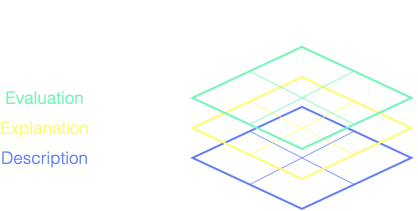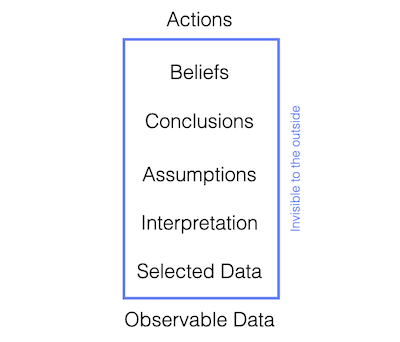Two Solutions, one Problem?
Have you ever wondered how it can happen that two capable, well-informed people propose two very different solutions to a problem? Sitting in a meeting and listening to the problem description, one person says we must do A, and the other person insists on doing B, which is not a nuance of A, but something completely different?
What’s going on here?
Internal Maps
We all carry with us internal maps that we create to navigate the outside world. These maps are invisible from the outside and cover three different layers of sense-making:
- Description. On this layer, the map is simply showing what we are experiencing. There’s no judgement, no interpretation. Just the sensory input.
- Explanation. On this layer, we’re trying to make sense of what the map of layer one is showing.
- Evaluation. When we’re evaluating, we’re passing judgment. Is what is going on in layer 2 good, bad, neutral?
In everyday life, we struggle to keep these layers separated. Very often we take shortcuts neither we nor the people around us recognise as such. For example, “It was a successful event, everybody was happy.” will typically pass as a description, when it actually is an evaluation. A description of “happy people” might be that they were smiling a lot. That we’re smiling and laughing when we feel feelings of happiness is an explanation, and that that the event was a success because “everyone was happy” is an evaluation of that explanation.

When it comes to finding solutions to problems, we turn to our internal map containing explanations. Evaluations are used to decide if something is a problem in need of fixing, and we’re not capable to create anything out of descriptions.
That’s why solutions always come from layer 2. Understanding why something happened is the key to understanding how to deal with it.
The problem arises when people might share the same ideas about layer 1 and layer 3 (they are seeing the same things, and they evaluate them in the same way), but have differences in layer 2 (why the things they witnessed happened).
That’s why people who witness the same event and share the same evaluation of it and its consequences, can come up with different ideas on how to react to it:
They have different explanations for why the event happened.
Both parties have good explanations Why something happened, and to them, their solution is the most reasonable thing. It is difficult for them to understand why anyone could come to any other conclusion.
Add to that the The Illusion of Transparency, which gives us the impression that everyone around us knows why we’re thinking what we’re thinking, plus our inability to keep our three internal maps separated, and it’s basically guaranteed that the differences on layer 2 are never uncovered, and never addressed.
Common ground cannot be established because we’re unaware that we don’t have it.
The Wrong Approach: Focusing on the Obvious Differences
All too often, we jump on the things people say or do, and start an argument about them.
Clearly, something must be wrong with their reasoning, or otherwise they would come to the same conclusion as us. Maybe if we’d only talk about our solution more, they would see the merits of it and agree that our way is the best way. After all, the The Illusion of Transparency makes us believe that our thought process is perfectly transparent.
And since the other person tries exactly the same thing, the result is a fruitless discussion about what to do next, with lots of back-and-forth, talking past each other, and in the end a win-or-lose situation where one idea is pitted against the other.
When we focus on visible actions, and things people say or do, we set the stage for confrontation. By simply proclaiming that someone else is wrong, and we are right, we start to argue about the last link in a long chain of sense-making.
The problem is: This last step might be right for everyone. The differences lie much deeper, but just arguing back and forth about the outcomes almost guarantees that we will never uncover the true misalignment, and we will never come to a shared understanding or at least knowledge of where we disagree.
A Practical Tool For Decoding Differences in Explanation: The Ladder of Inference
To break out of this fruitless pattern, start backtracking the thinking process and see where there is no shared understanding.

The “Ladder of Inference” captures the way our thought processes work - from the initial observation of data up to the actions we take. In a sense, it shows how we construct our internal maps.
This is what makes the “Ladder of Inference” such a great tool to uncover any misalignments or differing interpretations along the thinking process between people.
If you encounter something that indicates differences in the solution-creation process (people proposing very different solutions, people taking different types of action), you can uncover the misalignment by “walking up” the Ladder of Inference from observed data to actions that are being taken.
To do so, follow these steps:
- Start by creating a shared understanding of the observable data. Do we experience the same thing?
- What data is considered relevant and selected for further evaluation?
- How is the data interpreted? What meanings are added to it?
- What assumptions are added, based on that interpretation? Data is usually incomplete, how is it filled to create a coherent picture?
- Which conclusions are drawn from the data once it is made complete with assumptions?
- What is then believed to be true (about the data, and the world in general)
- What actions are proposed or taken, based on that beliefs?
As you walk up the ladder, listen closely to what the other person says, and how this aligns with what you’re thinking. If there’s a match, move to the next step. If you’re puzzled or would want to disagree, you know you’ve hit a stage where you do see things in a different way.
Get curious, and dig deeper. Where does this misalignment come from? Can you agree on a shared view and re-align your internal maps?
And if you cannot, at least you know where your differences come from.
Using the Ladder of Inference
Although it looks quite convoluted at first, the Ladder of Inference is actually a practical tool that can be used organically in all different types of situations.
You can use it in a more formal way in a workshop setting (like the very versatile What, So What, Now What? liberating structure), where you walk a group of people through the ladder step by step, collecting ideas and insights as you go.
You can also use it in a very informal way in conversations, where it takes on a feeling of inquiry, and trying to understand where the other person is coming from. In such a situation, it probably feels more natural to skip labelling the levels of the ladder or even mentioning them. That’s how I use it, in any case.
It’s easy to forget that we carry with us these internal maps all the time. And in our “What You See Is All There Is” (Daniel Kahneman) way of thinking, it’s equally easy to focus on that we come to different conclusions, instead of why we come to different conclusions.
To break the pattern and move forward, try the Ladder of Inference to create a deeper shared understanding of how and why people see things differently.